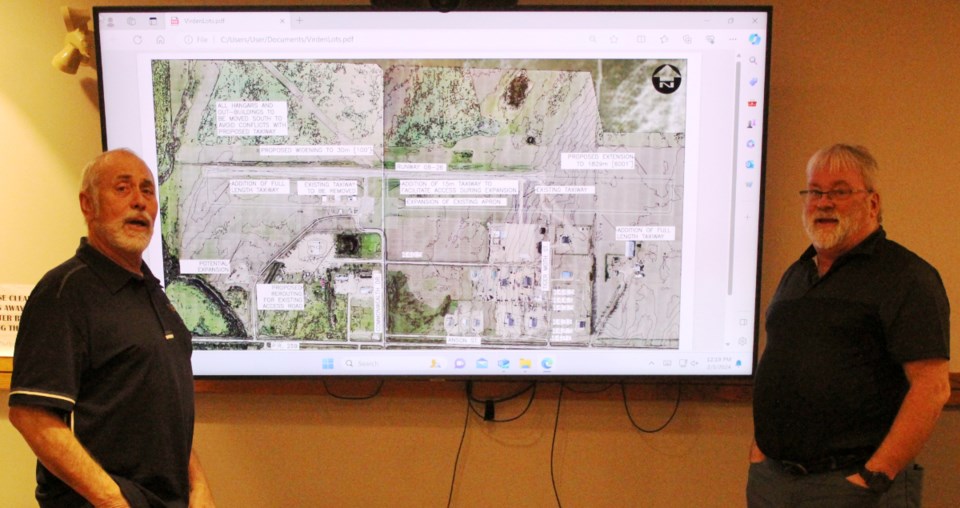It’s exciting days for Virden’s regional airport. The R.J. (Bob) Andrew Field Regional Aerodrome is about to receive an upgrade that will mean more planes and larger planes can use the airport more days of the year. This new capability will better serve medical flights and will be a boon to business in the area.
The entire upgrade is budgeted for $8.357 million. The project plan is in three phases, the first phase being the imminent move of four hangars from the north side of the runway to a south location to allow for a larger runway.
President of the airport commission, Virden councillor Bruce Dunning, says the plans include the installation of an Automated Weather Observing Systems (AWOS) that measures cloud heights and ceilings.
Along with many infrastructure changes to accommodate moving the hangers, the runway needs to be expanded to meet Canadian aviation standards. It will be lengthened from 4,300 feet to 6,000 feet and widened by 25 feet to become 100 feet wide.
The minimum ceiling (lowest point landing pilots can descend to before making visual contact with the runway) is currently 500 feet in Virden. The rules now allow for a minimum ceiling of 250 feet for airports like Virden's.
Transport Canada regulations changed in 2018 to allow the new minimums and these planned upgrades with a longer, wider runway will mean that planes can land in low cloud cover.
Scott Andrew who runs commercial flights and a flight school Air Andrew Ltd. is on the airport commission board. He says, “We can affect the minimums, but we can't affect the ceiling. Mother Nature does that.”
On a socked in, foggy morning in early February, Andrew says that with Virden’s current 500-foot ceiling, landing here would be impossible. “You're not getting in here. We landed in Brandon yesterday, because we couldn't get in here. Brandon is 250.”
This brings up the critical matter of medical flights that rely on Virden’s airport. With the current 500-foot ceiling, and appraising the forecast, Andrew says, “If you're the heart attack[patient] that needs to life flight to Winnipeg, you're not getting it for the rest of this week.” That needs to change.
Dunning estimates that some 50 medical flights used Virden’s airport last year. While the medical flight service uses fixed-wing aircraft capable of landing on a 4,300-foot runway, the capability to land and take off at a lower ceiling, will increase the number of days of service for medical, and for all flights.
“PMH recognizes that Virden Health Centre, due to its location on Number One Highway and with an ER operating 24/7, remains a very important acute care site within the region,” says Treena Slate, Regional Lead Acute Care of Prairie Mountain Health. Air ambulance use is an increasing need.
In addition to emergencies, the air service takes a load off ground ambulance service.
“The increase in medical flight traffic at Virden Municipal Airport is related to Shared Health’s use of non-critical air transport service in southern Manitoba since 2022,” said Jason Permanand, communications specialist for Manitoba Shared Health. “This service has increased our capacity for low-acuity transports in the region and enhances patient care in rural areas.”
Additionally, he says, “Using air transport for non-critical, long-distance or time-sensitive transfers to access diagnostics or care in larger centres allows ground ambulances and paramedics to focus more on 911 scene responses and higher-acuity interfacility transports in the community.”
The expansion of Virden’s regional airport also serves southwest Manitoba’s agriculture and industry sectors for aerial applications to crops, and even sometimes for bringing in hard to get industrial parts to keep the wheels of business turning. Corporate businesses also use the airport.
Virden and Moosomin have differing runway orientations, meaning that when wind conditions are wrong for Moosomin’s runway, customers can use Virden instead. “Moosomin has a cross wind runway benefit,” explains Andrew, so customers can also take advantage of that when the wind is wrong for Virden.
Air Andrew Ltd. operated out of the Virden airport by Scott and Brock Andrew and family has recently donated $2.5 million toward the upgrade.
The project is before the provincial Minister of Municipal Affairs Ian Bushie with an ask of $4.67 million from the province. Further funding toward the $8.357M will come from the Town of Virden and from other fundraising.
Expansion of Virden’s R.J. Andrew Field Regional Aerodrome will have wide-spread effects for communities in southwestern Manitoba and into Saskatchewan. The airport commission hopes area businesses and municipalities will also reach into their pockets and support the upgrade.




